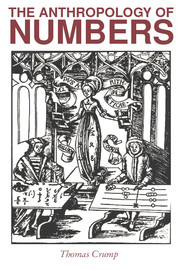Book contents
- Frontmatter
- Contents
- List of illustrations
- Preface
- Acknowledgements
- 1 The ontology of number
- 2 The cognitive foundations of numeracy
- 3 Number and language
- 4 Cosmology and ethnoscience
- 5 Economy, society and politics
- 6 Measurement, comparison and equivalence
- 7 Time
- 8 Money
- 9 Music, poetry and dance
- 10 Games and chance
- 11 Art and architecture
- 12 The ecology of number
- Notes
- References
- Index
- Cambridge Studies in Social and Cultural Anthropology
- Frontmatter
- Contents
- List of illustrations
- Preface
- Acknowledgements
- 1 The ontology of number
- 2 The cognitive foundations of numeracy
- 3 Number and language
- 4 Cosmology and ethnoscience
- 5 Economy, society and politics
- 6 Measurement, comparison and equivalence
- 7 Time
- 8 Money
- 9 Music, poetry and dance
- 10 Games and chance
- 11 Art and architecture
- 12 The ecology of number
- Notes
- References
- Index
- Cambridge Studies in Social and Cultural Anthropology
Summary
The role of number in visual representation
From the perspective of the culture of numbers the visual arts dispose of a tabula rasa, a blank space which can be filled with any sort of representation suitable to the medium used, with the implicit understanding that it will be intelligible to those who are likely to look at it. What may be represented must fit into the cognitive framework of the local culture, and may be further subject to political or religious restrictions. The representation will be a part of a symbolic universe in which numbers have their own part to play. There is no need for a literate culture, in the strict sense, and even where numbers can be represented in writing, their symbolic representation in the field of art is by no means limited to the standard written forms. From the time of the Ming dynasty (1368–1644) different flowers were used to symbolise the twelve months – which in Chinese are simply named after the numerals from one to twelve – so that the magnolia, for instance, connotes the number, two, or the chrysanthemum, the number, ten (Medley 1982: 412). This does not mean that every representation of a chrysanthemum connotes ‘ten’: this depends upon the context. In an appropriate case the standard written form for ten could conceivably connote a ‘chrysanthemum’.
- Type
- Chapter
- Information
- The Anthropology of Numbers , pp. 128 - 145Publisher: Cambridge University PressPrint publication year: 1990



